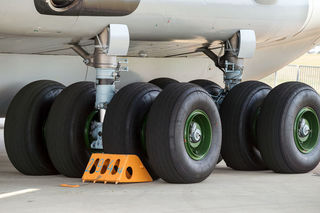Deception
Stories Told Out of Logical Sequence Indicate Deception
Can you solve the mystery of the stolen airplane tires?
Posted August 25, 2019

The following statement was written by a truck driver who mysteriously lost a pallet of three airplane tires off the back of his truck while he was driving from Los Angeles Airport to Lancaster, California. The airplane tires were very large tires used on experimental aircraft.
(1) Arrived LA dock 18:45 loaded 3 pallets to rental truck stack bed, 2 pallets airplane tires — 1 pallet with 2 boxes. (2) Departed LA dock 19:30 for Lancaster. (3) About 21:00 between top of truck ramp from I-5 to the 14 Freeway and camper pulls along side of me and tell me that a pallet had fallen out of the back of my truck. (4) And just before that when I got to the top of the truck ramp had pulled over to check straps on trucks — all 3 pallets were still aboard. (5) So, when I got to Sand Canyon Rd pulled off to check load and both straps + chain was loose or off of pallets and there was only 2 pallets on truck, 1 pallet of 2 boxes + 1 pallet of 3 airplane tires. (6) So, I turned around and went back toward LA looking for the missing pallet. (7) Found nothing. (8) Went onto Lancaster office. (9) Unloaded truck.
Sentences 1, 2, and 3 are in a logical sequence. Sentence 3, although in logical sequence up to this point in the narrative, contains the present tense words “pulls” and “tells,” which signal deception (See previous PT blog entry). Sentences 4, 5, and 6 are out of logical sequence, which indicate that this portion of the driver's statement is likely deceptive. One hypothesis posits that the driver wanted to ensure the reader that he checked the straps on his load before the driver of the camper notified him that the tires fell off the back of the truck. In other words, “It wasn't my fault because I checked the straps on the tires just minutes before the camper pulled alongside me.” Another hypothesis posits that the driver is covering up the theft of the airplane tires. Sentences 5, 6, 7, 8, and 9 are in a logical sequence. Based on the deceptive indicators, the theft occurred between the top of the truck ramp on I-5 and the 14 Freeway, the portion of the statement where the driver changed tense and described his actions out of logical sequence.
In summary, the driver’s statement is out of logical sequence and contains tense changes, which supports the hypothesis that the driver’s statement is deceptive. However, the driver’s statement does contain one word that provides the key to the truth. I challenge the readers to identify this word and develop a hypothesis as to what really happened. The solution to this mystery and a full psychological narrative analysis (PNA) of the driver’s statement will be presented in my next blog entry.
Some additional facts in this investigation include: (1) Interstate 5 (I–5) and the 14 Freeway are heavily traveled roadways, especially in the early evening rush hour traffic. (2) No 911 calls were made to the police reporting debris on the roadway. (3) No accidents were reported due to the pallet of tires falling off the truck. (4) The California Highway Patrol (CHP) sent patrol cars to look for the pallet of tires, but they could not find the pallet, the tires, or any debris from the cargo falling off the truck. (5) A truck pullout is located between the I-5 and the 14 Freeway split. The pullout is used by truck drivers to check the security of their loads before negotiating a steep downhill grade.


